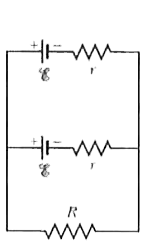A 24 V battery of internal resistance 4.0Ω is connected to a variable resistance. At what value of the current drawn from the battery is the rate of heat produced in the resistor maximum?
Step by step video & image solution for A 24 V battery of internal resistance 4.0 Omega is connected to a variable resistance. At what value of the current drawn from the battery is the rate of heat produced in the resistor maximum? by Physics experts to help you in doubts & scoring excellent marks in Class 12 exams.
Topper's Solved these Questions
Similar Questions
A 40 V battery of internal resistance 6Ω is connected to a variable resistor.At what value of the current drawn from the battery is the rate of heat produced in the resistor is maximum?
View SolutionA 40 V battery of internal resistance 6Ω is connected to a variable resistor.At what value of the current drawn from the battery is the rate of heat produced in the resistor is maximum?
View Solution
Knowledge Check
- Question 1 - Select One
A battery of e mf 10 V and internal resistance 3Ω is connected to a resistor as shown in the figure. If the current in the circuit is 0.5 A . then the resistance of the resistor will be
 A19ΩB17ΩC10ΩD12Ω
A19ΩB17ΩC10ΩD12Ω - Question 2 - Select One
A battery of internal resistance 2Ω is connected to a variable resistor whose value can vary from 4Ω to 10Ω. The resistance is initially set at 4Ω. If the resistance is now increased then
Apower consumed by it will decreaseBpower consumed by it will increaseCpower consumed by it may increase or may decreaseDpower consumed will first increase then decrease - Question 3 - Select One
A battery having e.m.f. 5 V and internal resistance 0.5Ω is connected with a resistance of 4.5Ω then the voltage at the terminals of battery is
A4.5 VB4 VC0 VD2 V
A battery of emf 2V and internal resistance 0.5(Ω)is connected across a resistance in 1 second?
View SolutionA battery of e.m.f 10V and internal resistance 3Omega is connected to a resistor.If the current in the circuit is 0.5A,then the resistance of the resistor is
View SolutionIn Fig. 27-38, two batteries with an emf ε=12.0V and an internal resistance r=0.500 Ω are connected in parallel across a resistance R. (a) For what value of R is the dissipation rate in the resistor a maximum? (b) What is that maximum? and (c) what is the total dissipation rate in the batteries? In terms of r, what are (d) the effective R (internal) resistance of the two-battery system and (e) the resistance R that is required to maximize the dissipation rate? This is a general result.
 View Solution
View SolutionA battery having e.m.f. 5 V and internal resistance 0.5Ω is connected with a resistance of 4.5Ω then the voltage at the terminals of battery is
View SolutionA battery of emf 15 V and internal resistance of 4Ω is connected to a resistor. If the current in the circuit is 2A and the circuit is closed. Resistance of the resistor and terminal voltage of the battery will be
View Solution

